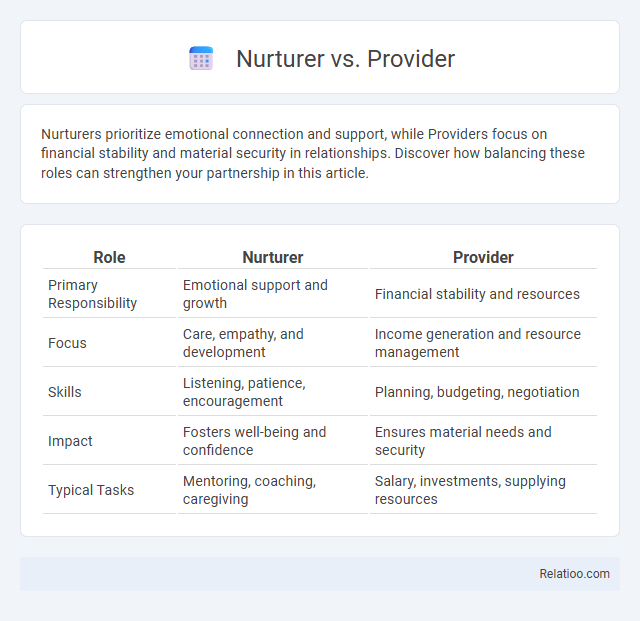Nurturers prioritize emotional connection and support, while Providers focus on financial stability and material security in relationships. Discover how balancing these roles can strengthen your partnership in this article.
Table of Comparison
| Role | Nurturer | Provider |
|---|---|---|
| Primary Responsibility | Emotional support and growth | Financial stability and resources |
| Focus | Care, empathy, and development | Income generation and resource management |
| Skills | Listening, patience, encouragement | Planning, budgeting, negotiation |
| Impact | Fosters well-being and confidence | Ensures material needs and security |
| Typical Tasks | Mentoring, coaching, caregiving | Salary, investments, supplying resources |
Understanding the Nurturer and Provider Roles
Understanding the Nurturer and Provider roles is essential for balancing emotional support and practical needs in relationships. The Nurturer focuses on offering empathy, care, and emotional connection, nurturing your well-being through compassion and attentiveness. In contrast, the Provider concentrates on ensuring financial stability and physical security, creating a foundation for safety and comfort in daily life.
Historical Context of Nurturer vs Provider
The historical context of Nurturer vs Provider roles reveals deep-rooted societal divisions where Providers traditionally focused on external resources and economic stability, while Nurturers concentrated on emotional support and caregiving within the family unit. Over time, cultural expectations reinforced the Provider as the primary breadwinner and the Nurturer as the home caretaker, shaping gender roles and family dynamics strongly. Understanding this evolution helps you recognize how modern shifts challenge these binary roles, emphasizing the importance of balance in nurturing and providing responsibilities.
Key Traits of a Nurturer
Key traits of a nurturer include empathy, patience, and a strong desire to support others emotionally and physically. They excel in creating safe environments, offering comfort, and fostering growth through attentive care and understanding. Unlike providers who focus on material support, nurturers prioritize emotional connection and healing, making them essential in relationships and caregiving roles.
Core Attributes of a Provider
The core attributes of a Provider include reliability, resourcefulness, and a strong sense of responsibility, ensuring your needs are consistently met through practical support and financial stability. Providers prioritize security and long-term planning, demonstrating commitment by safeguarding your well-being and fostering a dependable environment. Their ability to balance nurturing with pragmatic action distinguishes them in both personal and professional relationships.
Nurturer vs Provider in Modern Relationships
In modern relationships, the distinction between nurturers and providers centers on emotional support versus material contribution. Nurturers prioritize empathy, care, and fostering emotional intimacy, while providers emphasize financial stability and practical resources. Balancing these roles can enhance relationship satisfaction by addressing both emotional needs and tangible security.
Balancing Nurturing and Providing
Balancing nurturing and providing involves integrating emotional support with practical resources to create a stable and loving environment. Effective caregivers prioritize both empathetic connection and material provision, ensuring that emotional needs and physical necessities are met consistently. Mastery of this balance enhances overall well-being and strengthens relational bonds.
Gender Stereotypes and Expectations
Gender stereotypes often label nurturers as predominantly female, emphasizing empathy and caregiving, while providers are seen as male, associated with financial support and strength. These expectations limit individuals by enforcing rigid roles, ignoring that Your capacity to nurture or provide is not determined by gender but by personal traits and circumstances. Challenging these stereotypes promotes equality, allowing everyone to embrace diverse roles beyond traditional norms.
The Impact on Family Dynamics
The Nurturer role emphasizes emotional support and empathy, fostering strong bonds and open communication within the family. The Provider role focuses on financial stability and resource management, establishing security and meeting practical needs essential for family well-being. Balancing these roles shapes family dynamics by blending emotional nurturing with material support, promoting both harmony and resilience.
Nurturer and Provider Roles in the Workplace
The Nurturer role in the workplace emphasizes emotional support, team cohesion, and employee well-being, fostering a positive and collaborative environment. The Provider role focuses on delivering necessary resources, ensuring operational efficiency, and maintaining organizational stability through task management and resource allocation. Both roles are critical for balancing empathy with productivity, promoting sustainable workplace dynamics.
Embracing Fluidity: Redefining Traditional Roles
Embracing fluidity in roles challenges the traditional boundaries between nurturer and provider by recognizing the dynamic nature of caregiving and responsibility-sharing in modern relationships. This shift emphasizes emotional intelligence and flexibility, allowing individuals to alternate between nurturing and providing roles based on situational needs rather than fixed gender or societal expectations. The redefinition fosters equitable partnerships where contributions are valued for their impact rather than their alignment with stereotypical roles.

Infographic: Nurturer vs Provider
 relatioo.com
relatioo.com